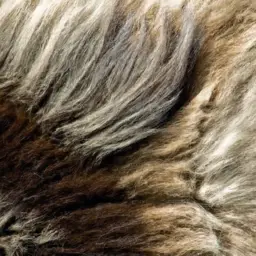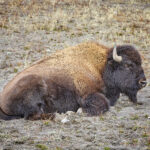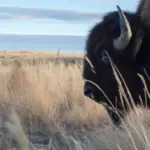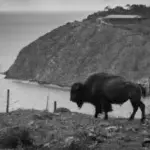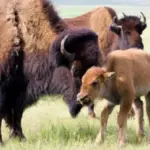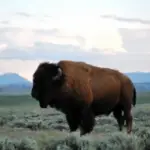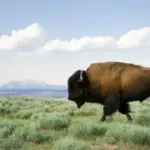Imagine being able to explore the vast world of bison species and unravel the fascinating mysteries surrounding their existence. With the product “How Many Species Of Bison Are There,” you have the opportunity to dive into a captivating exploration of bison taxonomy and discover the diverse range of species that roam our planet. Embark on this informative journey that sheds light on the intricate web of these majestic creatures and expands your knowledge about the incredible biodiversity our world has to offer.
Understanding the Bison Species
Bison, also known as buffalo, are majestic and iconic creatures that have captured the imagination of people around the world. They are large, sturdy mammals belonging to the Bovidae family, alongside other ungulates such as cattle, sheep, and goats. In this comprehensive article, we will delve into the fascinating world of bison, exploring their traits, habitat, and distribution. Additionally, we will discuss the two main types of bison: the American bison and the European bison. Furthermore, we will examine the extinct species of bison, the conservation status of bison, their importance in the ecosystem, human interaction with bison, and the future prospects for these magnificent creatures.
The Two Main Types of Bison
When it comes to bison, there are two primary types known to humans: the American bison (Bison bison) and the European bison (Bison bonasus). While they share certain similarities, they also exhibit distinct characteristics and occupy different regions of the world.
The American Bison
The American bison, also commonly referred to as the American buffalo, is an iconic symbol of the American West. These magnificent beasts are characterized by their large size, robust build, and impressive horns. Adult males, known as bulls, can reach heights of up to six feet and weigh over 2,000 pounds, making them one of the largest land mammals in North America.
The European Bison
The European bison, also called the wisent, once roamed the vast forests of Europe in great numbers. Today, their range has significantly diminished, and they are mostly found in a few select countries, including Poland, Belarus, Russia, and Lithuania. Similar to their American counterparts, European bison are known for their impressive size and strength. However, they possess distinctive features, such as a larger head and longer hair, setting them apart from American bison.
The American Bison
Description and Features
The American bison possesses an awe-inspiring presence, with a massive head, a hump on its shoulders, and a shaggy and rough dark brown coat. The males are larger than the females and are adorned with impressive curved horns that can span up to two feet in length. These horns are instrumental in combat during the mating season, as males vie for dominance and the opportunity to mate with females.
Habitat and Distribution
Historically, the American bison ranged across vast swathes of North America, from Canada down to Mexico. They thrived in diverse habitats, including grasslands, prairies, and even forests. Unfortunately, due to human encroachment and unsustainable hunting practices, their population dwindled dramatically. Today, efforts have been made to preserve and reintroduce them into protected areas, where they can find suitable habitat to roam freely.
Behavior and Lifestyle
American bison are social animals that tend to form large herds comprising females, their offspring, and a few dominant males. These herds provide safety and security against predators, such as wolves and bears. Bison are known for their strong sense of community and cooperation within their groups, ensuring the survival and well-being of each member. They communicate through various vocalizations, including grunts and bellows, and employ body language to convey intentions and maintain herd cohesion.
Feeding Habits
Being herbivores, American bison primarily feed on grasses, sedges, and other low-lying vegetation. Their broad muzzles and powerful jaws make them adept grazers, capable of consuming large quantities of plant matter each day. They play a crucial role in shaping the landscape through their grazing habits, as their movement and feeding patterns promote the growth and diversity of vegetation in their habitats.
Mating and Reproduction
Bison mating season, also known as the rut, typically occurs during the summer months. During this time, the dominant bulls engage in fierce battles to establish dominance and gain mating opportunities. These battles involve headbutting and displays of strength, with the victor earning the right to mate with receptive females. Once a successful mating has occurred, the gestation period lasts approximately nine months, after which a single calf is born. Bison calves are precocial, meaning they can walk and follow their mothers shortly after birth.
Subspecies of The American Bison
Within the American bison species, two distinct subspecies exist: the Plains bison (Bison bison bison) and the Wood bison (Bison bison athabascae). While they share many similarities, there are several notable differences between these subspecies.
The Plains Bison
Plains bison are the most widespread subspecies of American bison, historically populating the vast grasslands of North America. They are slightly smaller in size compared to Wood bison, with a lighter coat coloration and shorter hair. Plains bison are highly adaptable to different ecosystem types and have proven resilient in the face of adversity.
The Wood Bison
Wood bison, on the other hand, are the larger of the two subspecies, possessing a stockier build, a darker coat, and longer hair. Found primarily in the boreal forests and tundra regions of Canada and Alaska, Wood bison have faced significant challenges to their population due to habitat loss and overhunting. However, conservation efforts have been instrumental in safeguarding their existence, and their numbers have slowly started to recover.
Comparison of the two subspecies
Both Plains and Wood bison play vital roles in their respective ecosystems. While Plains bison have historically been more abundant and adaptable, Wood bison have the advantage of being larger and possessing distinct genetic traits. The preservation and conservation of both subspecies are crucial for maintaining the overall genetic diversity and health of the American bison species.
The European Bison
Description and Features
The European bison, also known as the wisent, is an impressive creature that once roamed the ancient forests of Europe. They exhibit several distinct physical features, such as a larger head, a more pronounced hump, and longer hair compared to the American bison. European bison can weigh up to 2,000 pounds, making them no less formidable than their American counterparts.
Habitat and Distribution
European bison have experienced a tumultuous past, facing near-extinction due to centuries of uncontrolled hunting and habitat loss. Today, thanks to conservation efforts and reintroduction programs, their range has expanded slightly, but they are still primarily found in a few select countries. These include the ancient Białowieża Forest in Poland, the Belovezhskaya Pushcha National Park in Belarus, and protected areas in Russia and Lithuania.
Behavior and Lifestyle
Similar to the American bison, European bison exhibit a gregarious nature, forming herds of varying sizes. Their herds are led by older, experienced females known as matriarchs, who guide the group to feeding areas and ensure the safety of their members. These herds provide a sense of bonding and offer protection against predators. European bison are known to communicate through a range of vocalizations, including growls, grunts, and snorts.
Feeding Habits
European bison are herbivores that rely on the abundant vegetation found in their forested habitats. They feast on a diversity of plant species, including grasses, shrubs, and leaves from deciduous and coniferous trees. Their feeding habits contribute to the maintenance and regeneration of forests, as they disperse seeds through their feces and create openings for new growth by trampling vegetation.
Mating and Reproduction
Breeding season for European bison typically occurs during the late summer and early autumn. Bulls engage in competitive displays of strength and dominance, which involve intense shoving and headbutting. Once a dominant bull has secured mating rights, he will guard the receptive female, preventing other males from approaching. After a gestation period of about nine months, a single calf is born. European bison calves are highly dependent on their mothers in the early stages of life, staying close to them for protection and nourishment.
Extinct Bison Species
Throughout history, several species of bison have tragically become extinct due to a combination of factors, including climatic changes and human activities. While these creatures no longer roam the Earth, their existence offers valuable lessons in wildlife conservation.
The Ancient Bison
The ancient bison, also known as Bison antiquus, was a species that lived during the Pleistocene era, around 10,000 years ago. These bison were larger than their modern counterparts, with towering horns and a distinctive hump on their shoulders. Factors such as climate change and overhunting by early humans are believed to have led to the demise of this magnificent species.
Steppe Bison
Steppe bison, scientifically known as Bison priscus, were once widespread across parts of North America, Europe, and Asia. These bison inhabited grasslands and tundra regions, adapting to the harsh conditions of the Ice Age. However, as the climate changed and human hunting intensified, their numbers dwindled, ultimately resulting in their extinction.
Long-Horned Bison
Long-horned bison, or Bison latifrons, were notable for their spectacular horns, which exceeded six feet in length. These massive creatures inhabited North America during the Pleistocene era, coexisting with other now-extinct megafauna such as mammoths and saber-toothed cats. Similar to other extinct bison species, the long-horned bison faced dramatic population declines due to climate shifts and increased hunting pressure.
Reasons for their extinction
The extinction of these ancient bison species can be attributed to various factors, most notably environmental changes and human activities. Rapid climate shifts, such as the end of the Ice Age, caused drastic alterations to their habitats and the availability of food sources, making survival increasingly challenging. Moreover, early human populations relied on bison as a vital resource for food, shelter, and other materials, leading to unsustainable hunting practices that exacerbated their decline.
Conservation Status of Bison
The conservation efforts dedicated to various bison species have been essential in ensuring their survival and promoting ecosystem health. However, numerous threats continue to pose challenges to their long-term viability.
Threats to Bison Species
Bison face several threats to their existence, with habitat loss and fragmentation being one of the most significant. Human activities, such as agriculture, urbanization, and infrastructure development, have resulted in the destruction and fragmentation of their historical ranges. This loss of habitat restricts their movement, disrupts social structures, and limits their access to adequate food and water sources. Additionally, climate change poses a considerable threat, altering ecosystems, and potentially impacting the availability of suitable habitat for bison.
Efforts towards conservation
Numerous organizations, government agencies, and conservationists have recognized the importance of bison conservation and have taken action to protect these magnificent creatures. Efforts include the creation of wildlife sanctuaries and national parks, reintroduction programs, and the establishment of captive breeding programs to maintain genetic diversity. Furthermore, collaborations between different stakeholders, including indigenous communities and governmental bodies, have played a crucial role in implementing conservation strategies and ensuring the long-term survival of bison species.
Role of Wildlife Sanctuaries and Parks
Wildlife sanctuaries and national parks have been instrumental in safeguarding bison populations by providing protected areas for them to thrive. These designated areas allow bison to roam freely, engage in natural behaviors, and fulfill their ecological role. Sanctuaries and parks also serve as important sites for research, education, and public awareness, helping to foster a deeper understanding and appreciation for these magnificent creatures.
Bison and Human Interaction
The relationship between humans and bison dates back thousands of years, with indigenous communities across North America relying on these animals for sustenance, clothing, and spiritual purposes. However, as European settlers arrived on the continent, the dynamics of human-bison interaction shifted dramatically.
History of human-bison relationship
Indigenous peoples have long revered bison, viewing them as sacred creatures and deeply intertwining their lives with these majestic animals. Bison provided essential resources, including meat, hides, bones, and sinew, which were utilized for sustenance, clothing, and various tools. Tribes developed sophisticated hunting techniques, such as buffalo jumps and surround hunts, to ensure the sustainability of bison populations and minimize waste. The buffalo became an integral part of their cultural and spiritual practices, symbolizing strength, abundance, and interconnectedness.
Bison in agriculture and hunting
With the arrival of European settlers in North America, the relationship between humans and bison underwent a significant shift. As settlers expanded westward, bison were viewed as a threat to their agricultural activities and a means to control indigenous populations. The mass slaughter of bison, often done for sport or to clear land for farming and ranching, resulted in the decimation of countless herds and the near extinction of these iconic creatures. This period, known as the “Great Bison Slaughter,” stands as a poignant example of the impact of human activity on wildlife populations.
Impact of human activity on Bison species
The historical actions of humans, including habitat destruction, unsustainable hunting practices, and exploitation of bison, have had severe consequences for their populations. These activities directly contributed to the decline and near-extinction of several bison species, altering ecosystems and disrupting intricate ecological relationships. However, with increased awareness and concerted conservation efforts, steps are being taken to rectify past harms and restore the balance between humans and bison.
Importance of Bison in Ecosystem
Bison play a vital role in the ecosystems they inhabit, acting as keystone species and influencing various ecological processes. Their presence has profound effects on other species and the overall health of their habitats.
Bison as keystone species
Bison are considered keystone species due to the significant impact they have on shaping their ecosystems. Their grazing behavior helps maintain the balance between grasses and other plant species, preventing the dominance of certain vegetation types. Through their selective feeding, bison create openings in grasslands, allowing for the growth of a diversity of plants and promoting biodiversity. This, in turn, attracts a myriad of other species that rely on these habitats for food and shelter, thus enhancing ecological richness.
Effect of Bison on other species and their habitat
The influence of bison extends beyond their direct interactions with vegetation. By creating open spaces and disturbing soil through wallowing, bison facilitate the establishment of microhabitats and increase nutrient availability. This benefits an array of organisms, including insects, birds, and small mammals that rely on these resources. Bison also provide carrion for scavengers and create browsing opportunities for large predators, fostering a complex web of interdependencies within the ecosystem.
The role of Bison in nutrient cycling
Bison play a critical role in nutrient cycling, the process by which essential elements, such as nitrogen and phosphorus, are circulated within ecosystems. Their consumption of plant matter and subsequent deposition of nutrient-rich feces contribute to the replenishment of soil nutrients. This aids in the growth of plants, ensuring a continuous supply of food for other animals and maintaining the overall health and productivity of the ecosystem.
Do Different Bison Species Have Different Colorations?
Yes, different bison species do have varying colorations. The color of bison fur can range from dark brown to light brown, depending on the species. For example, the American bison has a dark brown fur coat, while the European bison typically has a lighter brown color.
The Future of Bison Species
As we look to the future, it is essential to consider the projected population trends and the potential impact of climate change on bison populations. Additionally, efforts to reintroduce bison into various regions play a vital role in preserving the existence of these magnificent creatures.
Projected population trends
Thanks to concerted conservation efforts, the population of certain bison species, such as the American bison, has shown signs of recovery. However, challenges remain, and continued monitoring and strategic management are necessary to ensure the sustained growth and long-term viability of bison populations. Establishing corridors for migration, protecting critical habitats, and maintaining genetic diversity are key factors in securing the future of these species.
Impact of climate change on Bison
Climate change poses a significant threat to the survival of bison populations. Rising temperatures, altered precipitation patterns, and changes in vegetation composition can disrupt their habitats and impact their access to food and water sources. Additionally, increased frequency and intensity of extreme weather events, such as droughts and wildfires, further jeopardize the well-being of bison. Adapting conservation strategies to account for the impacts of climate change and implementing sustainable land management practices are crucial steps in mitigating these threats.
Efforts for Bison reintroduction in various regions
Reintroduction programs have played a crucial role in restoring bison populations in areas from which they were extirpated. By identifying suitable habitats and implementing strict protection measures, these programs have successfully reestablished bison herds in various regions around the world. The reintroduction of bison not only aids in their conservation but also helps restore ecological balance and reconnect fragmented ecosystems. Through collaborative efforts, government agencies, conservation organizations, and local communities are working together to ensure successful reintroduction initiatives.
In conclusion, bison are remarkable creatures that have captivated humans for centuries. From their enormous size and resilient nature to their crucial role in shaping ecosystems, bison hold significant importance in the natural world. With continued conservation efforts, these majestic animals can thrive, bolstering biodiversity and inspiring awe and admiration for generations to come.

